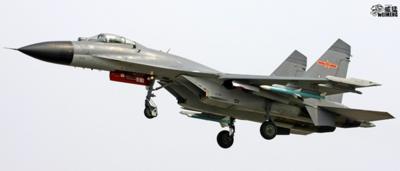Way Too Close For Comfort
As if in response to the Pentagon’s 17 October 2023 release of video evidence depicting a preponderance of reckless and antagonistic Chinese intercepts of U.S. warplanes, a Chinese fighter jet, on 24 October, closed within ten-feet of a U.S. Air Force B-52 bomber during a nighttime intercept over the South China Sea. U.S. Indo-Pacific Command deemed the Chinese pilot’s actions “unsafe and unprofessional.”

The incident marked the latest white-knuckle encounter of Chinese and U.S. combat aircraft in the region.
The Pentagon recently claimed in its annual China Military Power Report that Chinese military pilots have engaged in some 180 instances of “coercive and risky behavior” during the two-year period spanning autumn 2021 through autumn 2023. The cited number surpasses the sum total of such events transpired over the entirety of the previous decade.
The 24 October encounter merits particular attention, however, insofar as it occasions the first instance in which U.S. Indo-Pacific Command (USINDOPACOM) or the Pentagon have chronicled an unsafe intercept of a U.S. bomber. Moreover, the 24 October incident is the first such to occur in dark-of-night.
A video posted to social media appears to show a Chinese Shenyang J-11 fighter jet (NATO designation Flanker-L) approach and momentarily disappear behind a USAF B-52, only to reemerge an instant later.

Derivative of the Soviet-designed Sukhoi Su-27, the Shenyang J-11 is a twin-engine, supermaneuverable fighter aircraft conceived of as an air-superiority fighter and field by the Soviet Union in 1985.
In a press release USINDOPACOM set forth: “The PRC [People’s Republic of China] pilot flew in an unsafe and unprofessional manner, demonstrated poor airmanship by closing with uncontrolled excessive speed, flying below, in front of, and within ten-feet of the B-52, putting both aircraft in danger of collision.”
The release continued: “We are concerned this pilot was unaware of how close he came to causing a collision. The PRC intercept was conducted at night, with limited visibility, in a manner contrary to international air safety rules and norms.”
In previous instances, the Pentagon has called to light a pattern of aggressive, unprofessional behavior on the parts of PRC military pilots. The Chinese aviators have indulged in using explicit language when contacted over radio by U.S. crews, obscene gestures, and “flashing” their aircrafts’ weapons.

While the 24 October incident is the first in which a PRC combat aircraft has drawn so near a U.S. bomber, records exist of Chinese fliers closing to within ten-feet of U.S. fighter, attack, transport, and reconnaissance aircraft.
Multiple USAF B-52s are currently operating in the Indo-Pacific region as part of a Bomber Task Force rotation. One Stratofortress—the appellation ascribed to the B-52—recently made a rare landing on the Korean Peninsula while participating in the first-ever U.S., South Korea, Japan trilateral air exercise. Hailing from Louisiana’s Barksdale Air Force Base, the B-52s, for the duration of their deployment, are operating from Guam’s Andersen Air Force Base.
The USINDOPACOM press release concluded: “The U.S will continue to fly, sail, and operate—safely and responsibly—wherever international laws allow. The U.S. Indo-Pacific Command Joint Force remains dedicated to a free and open Indo-Pacific region, and we expect all countries in the Indo-Pacific to operate in international airspace safely and in accordance with international law.”
 Senator Pushes FAA to Accelerate Rocket Launch Licensing
Senator Pushes FAA to Accelerate Rocket Launch Licensing Classic Aero-TV: RJ Gritter - Part of Aviations Bright New Future
Classic Aero-TV: RJ Gritter - Part of Aviations Bright New Future Aero-FAQ: Dave Juwel's Aviation Marketing Stories -- ITBOA BNITBOB
Aero-FAQ: Dave Juwel's Aviation Marketing Stories -- ITBOA BNITBOB ANN's Daily Aero-Linx (10.27.24)
ANN's Daily Aero-Linx (10.27.24) ANN's Daily Aero-Term (10.27.24): Clearance Void If Not Off By (Time)
ANN's Daily Aero-Term (10.27.24): Clearance Void If Not Off By (Time)





